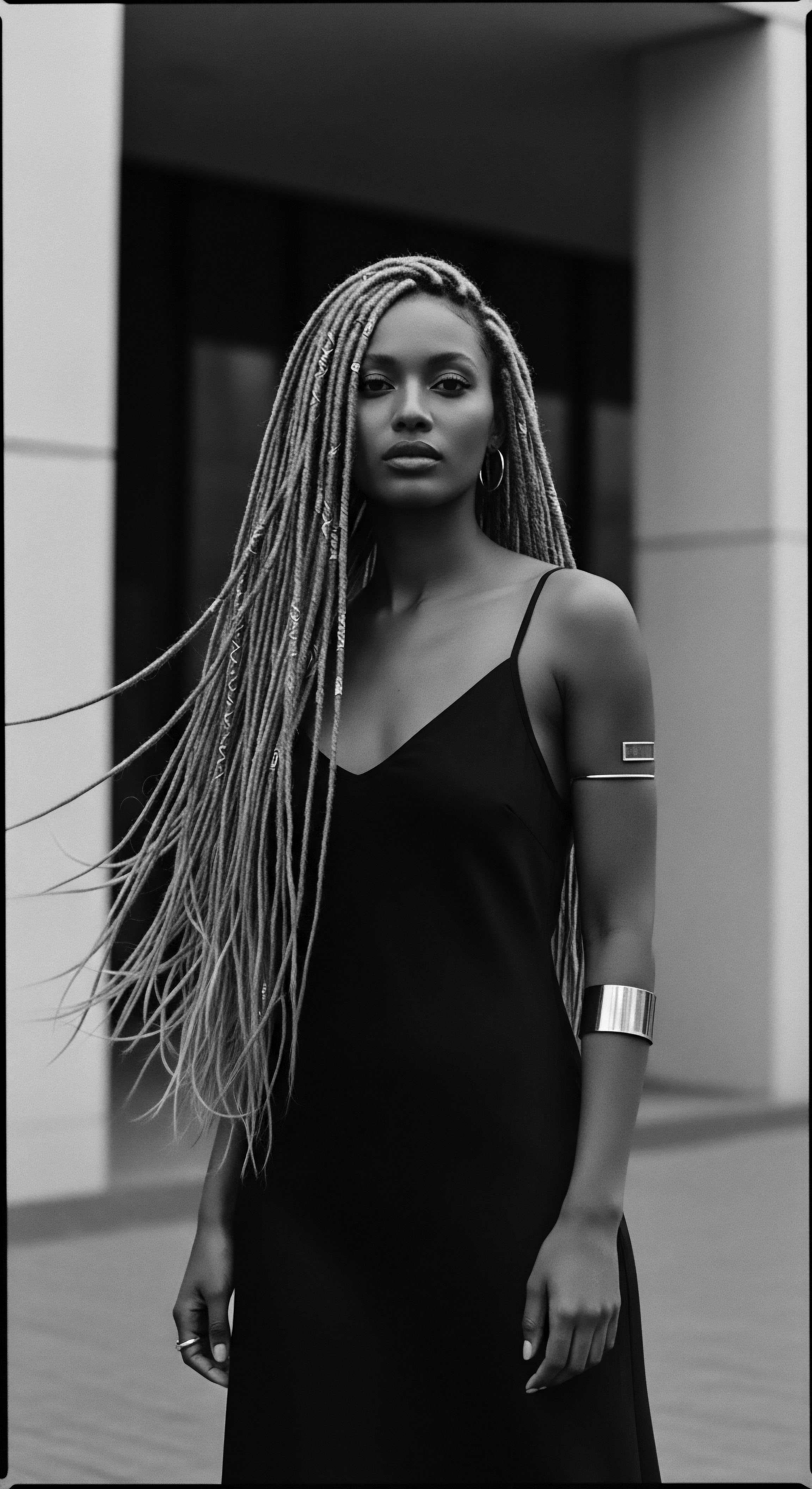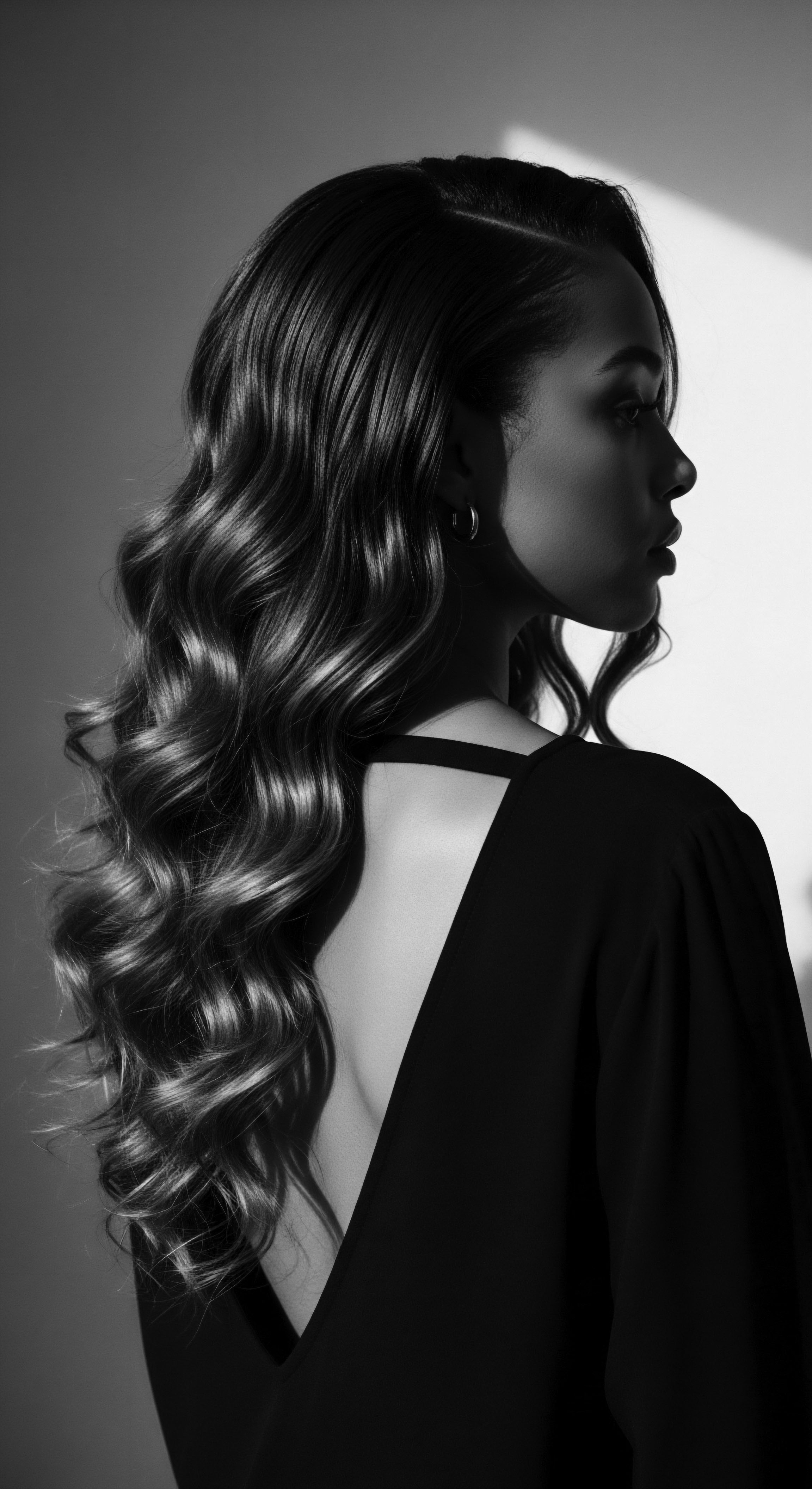
Roots
In the quiet heart of the Atlas Mountains, where ancient whispers carry through the windswept valleys, a deep earth wisdom sleeps. For those whose strands echo the boundless spirit of textured hair, the question of gentle cleansing holds a resonance beyond mere practicality. It speaks to a deep lineage, to practices passed down through generations, to the very heritage of self-care. Does Ghassoul clay truly cleanse textured hair with a tender hand?
To truly understand this, we must first look to the very beginnings, to the elemental biology of the strands themselves, and to the traditional practices that have long honored them. Our exploration begins not in a laboratory, but in the earth, in the very soil that cradled early human artistry and survival.

The Earth’s Embrace
Ghassoul clay, often called Rhassoul, finds its genesis in specific lacustrine sedimentary formations within Morocco’s Atlas Mountains. Its name, derived from the Arabic verb “ghassala,” translates directly to “to wash,” a simple yet powerful testament to its ancient purpose. For centuries, Berber women, custodians of a rich historical lineage, incorporated this mineral-rich clay into their beauty rituals within hammams, those communal spaces of purification and rejuvenation. This practice was not merely about superficial cleansing; it represented a deep connection to the earth, a recognition of natural elements as sources of profound care.
The distinctive properties of Ghassoul clay stem from its singular mineral composition. It primarily consists of stevensite, a magnesium silicate-based clay, alongside other valuable elements such as silica, calcium, iron, potassium, and sodium. These minerals contribute to its unique molecular structure, which, when mixed with water, creates a paste capable of absorbing impurities and excess sebum without stripping the hair’s natural moisture. This ability sets it apart from many harsher cleansing agents, a quality particularly important for textured hair, which naturally tends toward dryness and moisture loss due to its coil and curl patterns.

Textured Hair’s Ancient Resilience
Textured hair, with its coils, kinks, and waves, stands as a testament to the remarkable adaptability of human ancestry. Its very structure, often dense with spiral patterns, offered protection against intense ultraviolet radiation and allowed for air circulation to the scalp in the searing sun of ancient African landscapes. Across various African civilizations, hair care was far more than a simple routine; it served as a profound marker of identity, status, and community. Elaborate styles, adorned with beads and wrapped in fabrics, were communally fashioned, preserving hair health against environmental challenges.
The practices of these communities laid a foundation for understanding gentle care, often relying on locally sourced botanical blends and natural butters. The use of clay for cleansing and protection was a common thread across many indigenous tribes, from the Himba of Namibia using a mixture of clay and cow fat for sun protection and detangling, to other tribes employing various clays for hair cleansing and styling. These traditions speak to an innate wisdom, a knowing that true cleanliness respected the hair’s inherent moisture and vitality.
Ghassoul clay, deeply rooted in Moroccan heritage, offered ancient cultures a gentle, mineral-rich means to cleanse and honor textured hair.
The science of Ghassoul clay, though newly explored in modern laboratories, echoes this ancestral understanding. Its capacity to act as a natural shampoo, removing build-up without disturbing the scalp’s protective hydrolipidic film, aligns with the long-held objective of maintaining hair’s natural balance. This harmonizes with the principles of traditional African hair care, which centered on preserving natural oils and avoiding practices that would lead to breakage or excessive dryness. The history of textured hair care, then, becomes a living archive, where the elemental composition of the earth and the physiological needs of the hair intertwine in a narrative of sustained care.

Ritual
The passage of Ghassoul clay from the earth to our hands represents a continuation of ancient rituals, a tangible link to the ways our forebears honored their hair. This isn’t about rigid rules, but about understanding a flow of practices, a tender thread that connects traditional wisdom with contemporary needs. The preparation and application of Ghassoul clay for textured hair embody this living tradition, transforming a simple act of washing into a mindful engagement with one’s heritage.

Preparing the Earth’s Gift
In traditional Moroccan settings, the raw Ghassoul stones were never used directly. A ritualistic preparation, often a closely guarded family secret passed from mother to daughter, transformed the clay into its usable form. This process could involve maceration of the stones with water, sometimes infused with herbs such as orange blossom, chamomile, or lavender, creating a potent, fragrant blend. This thoughtful mixing, a bespoke alchemy, highlights a foundational understanding ❉ the interaction of water with the clay activates its cleansing power, allowing its unique mineral structure to bind with impurities.
When Ghassoul clay is moistened, it develops a smooth, almost lubricating consistency, akin to soap but without creating excessive foam. This characteristic is vital for textured hair, as it allows for thorough coverage and gentle manipulation without tangling or stripping strands. The clay’s primary mechanism involves ion exchange and absorption ❉ its negatively charged metallic elements attract positively charged toxins, excess oils, and accumulated product build-up.
This drawing action cleanses the scalp and hair deeply, yet its non-detergent nature ensures the hair’s inherent moisture balance remains undisturbed. This contrasts sharply with many modern shampoos containing harsh sulfates that can aggressively strip textured hair of its precious natural oils, leading to dryness and breakage.

Application’s Gentle Choreography
The application of Ghassoul clay to textured hair mirrors a deliberate, tender choreography. It begins with wetting the hair, preparing the strands to receive the clay’s embrace. The paste is then massaged into the scalp and along the hair, ensuring even distribution.
For tightly coiled or dense hair, sectioning becomes a practice of patience, allowing each coil to be touched by the clay’s cleansing caress. This gentle massage stimulates circulation to the scalp, a practice long valued in ancestral hair care for encouraging growth and maintaining scalp health.
A short period of resting with the clay, typically 5-15 minutes, allows the minerals to work their magic, binding to impurities and releasing their nourishing properties. The rinsing process, done with lukewarm water, is just as important, ensuring all clay particles are removed, leaving hair feeling clean, soft, and remarkably light. This multi-step ritual, from thoughtful preparation to careful rinsing, is a testament to the sustained, holistic approach to textured hair care that has long been a cornerstone of heritage practices.
The careful preparation and application of Ghassoul clay embody ancestral wisdom, cleansing textured hair while preserving its natural oils.
Consider the contrast between this mindful, heritage-informed approach and the often hurried, stripping practices of contemporary society. The ancestral methods emphasize slowness, connection, and a deep understanding of natural elements. They offer a template for current routines, guiding us toward choices that honor the unique needs of textured hair, ensuring it receives the gentle, preserving care it warrants.
The Himba People of Namibia exemplify the profound cultural integration of clay in hair rituals. They blend ochre clay with butterfat, herbs, and other aromatic resins to create ‘otjize,’ a paste applied daily to their skin and hair. This practice offers protection from the harsh sun and insects, moisturizes, and forms distinctive hairstyles that signify age and social status within the community (Crabtree, 2011). While distinct from Ghassoul, the Himba practice powerfully illustrates clay’s role in ancestral hair preservation and its intertwining with identity and climate adaptation, offering a parallel testament to clay’s heritage within African hair traditions.
| Traditional Application (Heritage) Prepared at home with water and sometimes herbs, passed down through generations for hammam rituals. |
| Scientific Understanding (Contemporary Link) The clay's molecular structure, primarily stevensite, absorbs excess oils and impurities without disrupting the scalp's natural balance. |
| Traditional Application (Heritage) Used for centuries by Berber women for gentle cleansing and revitalization of skin and hair. |
| Scientific Understanding (Contemporary Link) Rich in magnesium, silica, calcium, and other minerals, it cleanses while also offering conditioning and strengthening properties. |
| Traditional Application (Heritage) Application often involves gentle massage and patient rinsing to avoid tangling. |
| Scientific Understanding (Contemporary Link) Its non-detergent nature preserves the hair’s hydrolipidic film, preventing dryness common in textured hair. |
| Traditional Application (Heritage) This synergy of ancient practices and modern insight underscores Ghassoul clay's enduring value in textured hair care lineage. |

Relay
The echoes from the source and the tender choreography of ritual culminate in a powerful relay, carrying the legacy of Ghassoul clay into the present and toward the future of textured hair care. This section delves deeper, analyzing the intricate mechanisms behind Ghassoul clay’s cleansing action and its alignment with the specific needs of coils, kinks, and waves, all through the lens of a continuous heritage.

How Does Ghassoul Clay Interact With Hair’s Unique Physiology?
Textured hair possesses a distinct physiology that sets it apart. Its elliptical cross-section, coupled with the varied twists and turns of its growth pattern, makes it prone to dryness and breakage. The cuticle layers, which act as the hair’s protective outer shield, are often raised at the points of curl and coil, leading to moisture loss and increased susceptibility to damage. Traditional shampoos, laden with harsh sulfates, can exacerbate this by stripping away natural sebum, the scalp’s protective oil, leaving the hair vulnerable and brittle.
Ghassoul clay, conversely, functions through an absorbent action. Its charged mineral components act like magnets, drawing out excess oils, product residue, and environmental pollutants from the hair and scalp without causing the aggressive stripping that can compromise the delicate balance of textured strands. This distinction is crucial for hair health, particularly for those with a heritage of dryer hair types.
Studies have characterized Ghassoul clay, revealing its primary component to be stevensite, a magnesium-rich smectite. The unique lamellar or petalloid microstructure of this clay facilitates its cleansing capabilities. When hydrated, the clay particles expand and develop a mild negative charge on their surface. This allows them to adsorb impurities, which often carry a positive charge, a process known as cation exchange.
This physical binding and removal of grime stands as a stark contrast to the chemical emulsification process of many commercial detergents, which can dissolve and remove both desirable and undesirable lipids indiscriminately. The result is a clean feeling that does not compromise the hair’s inherent moisture.

Does Ghassoul Clay Maintain Scalp Health for Textured Hair?
A healthy scalp provides the very ground from which resilient textured hair can grow. Many traditional hair care practices across the African diaspora placed significant value on scalp vitality, understanding its connection to overall hair well-being. Ghassoul clay offers substantial benefits for scalp health. Its cleansing properties extend to removing dead skin cells and balancing sebum production, which can significantly help with common concerns like dandruff and an itchy scalp.
By absorbing excess oils and impurities, it unclogs follicles, creating a healthier environment for hair growth and reducing issues like painful bumps or ingrown hairs. This is especially relevant for textured hair, which sometimes experiences product build-up that can obstruct follicles and hinder proper hair development. The clay also has a soothing action, potentially reducing irritation and inflammation on the scalp, which has been an anecdotal benefit for centuries, now gaining some scientific attention. This historical application of clay as a soothing agent for the skin and scalp continues to be affirmed through contemporary understanding.
Ghassoul clay’s unique mineral structure offers a gentle yet effective cleansing for textured hair, honoring ancestral wisdom by preserving natural moisture.
The cultural significance of maintaining scalp and hair health is profound. In many African cultures, hair was a visible symbol of one’s identity, status, and connection to community. The meticulous care practices, often communal, underscored the collective value placed on healthy hair. The use of natural materials like Ghassoul clay connects present-day users to this rich heritage, a deliberate choice to align with practices that served communities well for centuries, fostering not only healthy hair but a sense of continuity and pride.
The enduring popularity of Ghassoul clay, despite the advent of modern cosmetic chemistry, speaks volumes to its efficacy and its embedded place in a tradition of respectful hair care. As we consider the journey of textured hair, from ancient adaptations to contemporary celebrations, Ghassoul clay stands as a testament to the profound and enduring wisdom found in nature’s offerings.
- Mineral Composition ❉ Ghassoul clay contains high levels of silica, magnesium, calcium, and potassium, all beneficial for hair and scalp health.
- Absorbent Action ❉ It cleanses by absorbing excess oil, impurities, and product build-up, rather than stripping natural oils.
- Scalp Balancing ❉ Helps regulate sebum production and remove dead skin cells, promoting a healthier scalp environment.
The continuous study of Ghassoul clay, exemplified by research into its physicochemical properties and mineralogical composition (Amakrane et al. 2018), further validates its ancestral uses. Such scientific inquiries often uncover the “why” behind the “what” of traditional practices, confirming the inherent wisdom of those who first discovered and passed down the knowledge of this remarkable earth element. This ongoing discovery creates a bridge between our inherited understanding and our expanding scientific comprehension, strengthening the legacy of Ghassoul clay as a gentle yet potent agent in textured hair care.

Reflection
The journey with Ghassoul clay, from its deep geological origins in the Atlas Mountains to its gentle application on textured strands today, reveals a truth beyond mere cleansing efficacy. It is a dialogue with the past, a whispered conversation across generations that reaffirms the profound heritage woven into every coil and curl. The question, “Does Ghassoul clay cleanse textured hair gently?” finds its most resonant answer in this continuity, in the enduring legacy of care and the mindful choices that echo ancestral wisdom.
We recognize Ghassoul clay as far more than a simple mineral compound. It stands as a symbol of resilience, a tangible connection to practices that sustained health and cultural pride through time. Its gentle action, preserving the inherent moisture of textured hair while purifying the scalp, serves as a living testament to the sophisticated understanding our ancestors held concerning natural elements and the unique physiology of Black and mixed-race hair. This knowledge, once passed through spoken word and embodied ritual, now finds validation in contemporary understanding, yet its heart remains rooted in the soul of a strand, a deep respect for the intrinsic nature of our hair.
In choosing Ghassoul clay, we honor a legacy. We participate in a tradition that views hair care as an act of reverence, a holistic engagement with self and with the earth. The clay’s journey from the Moroccan hammam to our own spaces of self-care is a powerful reminder that the most potent solutions often lie closest to the source, held within the traditions that have shaped us. As textured hair continues its unbounded helix through history, reclaiming its full expression, the earth’s quiet offerings, like Ghassoul clay, will surely continue to hold a treasured place, gently guiding us forward while anchoring us firmly in the wisdom of our collective past.

References
- Amakrane, A. Bouhfid, R. Aknin, N. & Bensalah, M. (2018). Mineralogical and physicochemical characterization of the Jbel Rhassoul clay deposit (Moulouya Plain, Morocco). Journal of Materials and Environmental Science, 9(9), 2549-2557.
- BIOVIE. (n.d.). What are the benefits of rhassoul clay? BIOVIE. Retrieved from
- Crabtree, K. (2011). The Himba of Namibia ❉ An Ethnographic Account. University of Wisconsin-Madison Libraries.
- Demix International Consulting. (2021). RHASSOUL ❉ MOROCCAN CLAY. Demix International Consulting. Retrieved from
- Ecosystem Laboratoire. (2024). Ghassoul ❉ history, benefits and uses. Ecosystem Laboratoire. Retrieved from
- Fatima’s Garden. (n.d.). Frequently Asked Questions about Rhassoul Clay (Ghassoul Clay). Fatima’s Garden. Retrieved from
- Fatima’s Garden. (n.d.). Rhassoul Clay as a hair mask for deep cleansing. Fatima’s Garden. Retrieved from
- Healthline. (2019, November 11). Rhassoul Clay Benefits and Uses for Hair and Skin, and Precautions. Healthline. Retrieved from
- MINATURE. (2024, November 25). Benefits and Uses Of Moroccan Rhassoul Clay for Hair & Skin. MINATURE. Retrieved from
- My Chic Curls. (n.d.). Detox for Healthy Hair ❉ Unlock the Power of Rhassoul and Bentonite Clay. My Chic Curls. Retrieved from
- NATURAL POLAND. (2023, May 26). Ghassoul Clay The African Purifying Secret ❉ Benefits and Applications of Ghassoul Clay for Skin and Hair Care. NATURAL POLAND. Retrieved from
- Obscure Histories. (2024, February 13). Ancient Gems ❉ A Historical Survey of African Beauty Techniques. Obscure Histories. Retrieved from
- Reddit. (2021, August 26). No raw oils and butters vs. Traditional African hair care? r/Naturalhair. Retrieved from
- ResearchGate. (n.d.). Chemical composition of the Rhassoul clay and its fine mineral fraction. ResearchGate. Retrieved from
- ResearchGate. (n.d.). Analysis of traditional pharmacopeia product from Morocco ‘Rhassoul’. ResearchGate. Retrieved from
- Renaissance Henna. (n.d.). Natural Hair Wash Clay Rhassoul. Renaissance Henna. Retrieved from
- Renaissance Henna. (n.d.). Moroccan Rhassoul Clay. Renaissance Henna. Retrieved from
- Tara – Nature’s Formula. (n.d.). Ghassoul Clay. Tara – Nature’s Formula. Retrieved from
- The Clay Cure Co. (n.d.). Natural Rhassoul Skin & Hair Care Recipes. The Clay Cure Co. Retrieved from
- The Twisted Strands of Textured Hair History ❉ From Ancient Remedies to Modern Magic. (2024, April 7). Retrieved from
